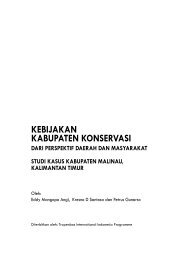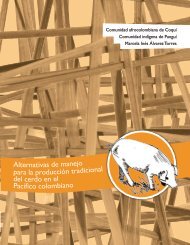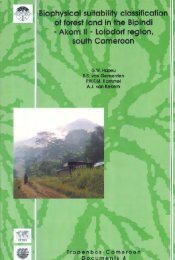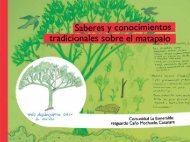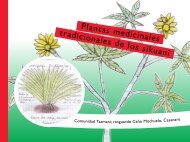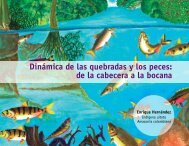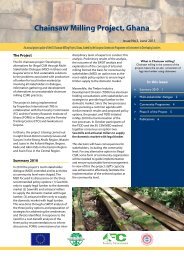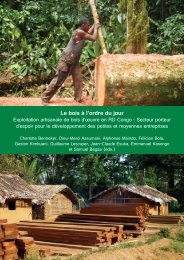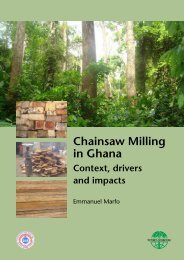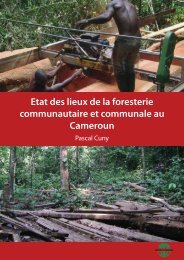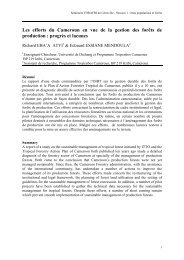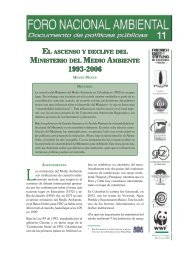Download the publication - Tropenbos International
Download the publication - Tropenbos International
Download the publication - Tropenbos International
You also want an ePaper? Increase the reach of your titles
YUMPU automatically turns print PDFs into web optimized ePapers that Google loves.
Central African tropical rain forest structure and composition<br />
contains many more coastal indicator species and less Caesalpinioideae than <strong>the</strong><br />
former. It is characterised by <strong>the</strong> frequent occurrence of Sacoglottis gabonensis that<br />
occurs in association with o<strong>the</strong>r tree species such as Coula edulis, Cynometra<br />
hankei, Lophira alata, Ochthocosmus calothyrsus and Pycnanthus angolensis. This<br />
forest type is heavily affected by human activities such as agriculture, logging, road<br />
construction, and urbanisation. It is ra<strong>the</strong>r difficult to find traces of undisturbed<br />
forest of this type despite its primary appearance in some areas.<br />
5. Coastal forest rich in Calpocalyx heitzii and Sacoglottis gabonensis (Cosaca).<br />
This vegetation type occurs in <strong>the</strong> Campo area between 0-100 m above sea level and<br />
represents a transitional zone where <strong>the</strong> evergreen forest rich in Caesalpinioideae,<br />
Calpocalyx heitzii and Sacoglottis gabonensis mixes with <strong>the</strong> coastal forest. As a<br />
result, it contains many more coastal indicator species and much less<br />
Caesalpinioideae than <strong>the</strong> latter. In addition to Calpocalyx heitzii and Sacoglottis<br />
gabonensis, <strong>the</strong> forest is dominated by tree species such as Alstonia boonei,<br />
Calpocalyx dinklagei, Coelocaryon preussii, Desbordesia glaucescens,<br />
Distemonanthus benthamianus, Greenwayodendron suaveolens, Lophira alata,<br />
Ochthocosmus calothyrsus, Pterocarpus soyauxii, Staudtia kamerunensis var.<br />
kamerunensis and Terminalia superba.<br />
6. Coastal vegetation on sandy shorelines (Cosas).<br />
It occurs along <strong>the</strong> coastline between Kribi and Campo, supporting a species-poor<br />
belt of low-canopy woody vegetation, often with herbaceous and shrubby maritime<br />
plant species. The foreshore is dominated by <strong>the</strong> typical Atlantic shore species<br />
Ipomea pes-caprae spp. brasiliensis that occurs on a low sandy coastline. Additional<br />
species are Andira inermis ssp. inermis, Remirea maritima, Dioda serrulata,<br />
Canavalia rosea, Ipomea cairica, Flagellaria guineense, Cassytha filiformis and<br />
Stylosan<strong>the</strong>s erecta. The seaward side bordering this formation is rich in maritime<br />
tree species such as Terminalia catappa, Syzygium guineense var. littorale, Phoenix<br />
reclinata, Chrysobalanus icaco spp. icaco, Manilkara obovata, Calophyllum<br />
inophyllum, Carapa procera, and Cocos nucifera. Hibiscus tiliaceus, a species<br />
characteristic of tropical shores also occurs here in association with o<strong>the</strong>r coastal<br />
species such as Dodonaea viscosa, Craibia atlantica, Lonchocarpus serieus,<br />
Dalbergia ecastaphyllum, Mucuna flagellipes and Tetracera alinifolia.<br />
7. Mixed evergreen and semi-deciduous forest, with elements of evergreen lowland<br />
forest predominant (Mixevergreen).<br />
This vegetation type occurs mostly in <strong>the</strong> western part of Ma’an, and in <strong>the</strong> eastern<br />
part of <strong>the</strong> Campo-Ma’an National Park at altitudes between 100-700 m. Here <strong>the</strong><br />
forest has a fairly closed canopy though, patches of open areas are occasionally<br />
found where <strong>the</strong> forest is poorly developed. It contains many more elements of <strong>the</strong><br />
lowland evergreen forest rich in Caesalpinioideae and <strong>the</strong> canopy is dominated by<br />
tree species such as Anthonotha fragrans, Calpocalyx dinklaigei, Canarium<br />
schweinfurthii, Erythrophleum ivorense, Plagiostyles africana, Petersianthus<br />
macrocarpus, Pycnanthus angolensis, Santiria trimera, Strombosiopsis tetrandra,<br />
Tabernaemontana crassa, Stachyothyrsus staudtii and Uapaca guineensis. The<br />
understorey is dominated by shrub species such as Alchornea floribunda, A. hirtella,<br />
Asystasia macrophylla, Haumania danckelmaniana, Heisteria parviflora,<br />
27



